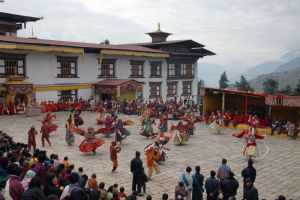The Dance of the Eight Manifestations of Guru Rinpoche (Guru Tshen Gye)
In Religious Festivals, Ceremonies & Rituals, Bhutan | Updated: August 31, 2013 2:35 pm The Eight Aspects under which Guru Rinpoche manifested himself on various occasions appear in a procession with the principal aspect of Guru Rinpoche shaded by a parasol. Certain other aspects are accompanied by their retinues and small celestial beings. In order of appearance they are:
Dorje Droloe, ‘Liberated Diamond-Thunderbolt’, who wears a terrifying dark red mask and a garland of skulls around his body holds a diamond-thunderbolt (dorje) and a ritual dagger (phurpa). He earned this name after vanquishing evil spirits who were creating obstacles to Buddhism at Taktshang in Paro and Singye dzong in Kurtoe. Dorje Droloe is followed by his entourage of fearsome deities.
Tshokye Dorje, ‘Diamond-Thunderbolt Born from a Lake’, who is dressed in blue brocade and wears a peaceful blue mask, carries in his hands a diamondthunderbolt and a small bell. His name derives from his miraculous birth in a blue lotus on Lake Dhanakosha.
Loden Chogse, ‘He Who Wishes to Acquire Supreme Knowledge’, who wears a robe of red brocade and a white mask with a knot of hair and a crown, holds in his hands a little drum and a bowl. He got this name after he had listened to the teachings of the Vajrayana and mastered the sciences inculcated by the Indian masters; tutelary deities then appeared to him.
Padmasambhava, ‘Born of the Lotus’, clad in a monk’s robe of dark red and yellow, wears a white mask with a pointed red hat, a so-called pundit’s hat. He got his name after he used his supernatural powers to transform the wood-pile (on which the king of Zahor wanted to burn him alive) into a lake.
Guru Rinpoche, ‘Most Precious Master’, is the chief aspect, yet he is not listed as one of the Eight Aspects. He wears a human mask of gilded copper crowned by his characteristic hat and is attended by two monks while a third shades him with a parasol.
Shakya Sengye, ‘Lion of the Shakya Family’, clad in a red and yellow monk’s robe, wears a mask resembling Buddha’s face with a hairstyle of tight blue curls, holds a begging bowl in his hands. He was called by this name when, after having renounced his kingdom, he went to meditate and study in the cave of Maratika in Nepal with the master Prabahati.
Pema Gyelpo, ‘Lotus-King’, who wears a robe of red brocade and a pinkishorange mask with a beard, holds in his hands a mirror and a small drum. He got this name when he returned to his native kingdom of Ogyen (Oddhyana); at that moment the chiefs of the country wanted to burn him but could not succeed in doing so. Seeing this as a sign of the spiritual realization of Guru Rinpoche, they converted to Buddhism and offered him the Kingdom.
Nyima Oezer, ‘Sunbeam’, who is dressed in yellow brocade, wears a yellow mask with a beard of blue hair and holds a trident in his hand. He got this name when, as he was preaching in the cremation grounds, he conquered evil spirits and made them promise to protect the Buddhist doctrine ever afterwards.
Sengye Drathok, ‘He with the Voice of a Lion’, is clad in blue brocade; his blue mask crowned with five skulls is terrifying. He was called by this name after the power of his words vanquished 500 heretical masters who had tried to destroy the doctrine of Buddhism.
The principal aspect of Guru Rinpoche is seated, whereas each of the other aspects, with the exception of Padmasambhava, dances before going to join the principal aspect. Then a public blessing takes place and the fervour of the people is fully demonstrated: the faithful press forward to receive a thread of blessing, not from a monk who represents Guru Rinpoche but from Guru Rinpoche himself, incarnated as a human being. The dance area is transformed into a heaven, and celestial beings adorned with bone ornaments come to dance and sing the praises of Guru Rinpoche. The dance concludes with a final procession and the exit of all the aspects of Guru Rinpoche.
